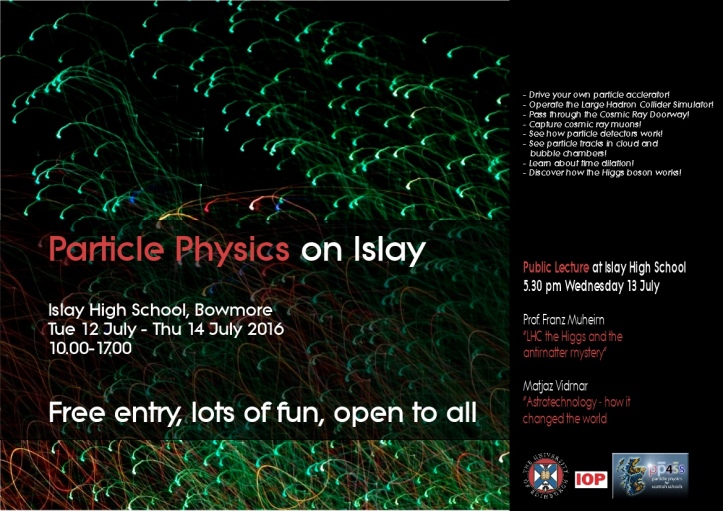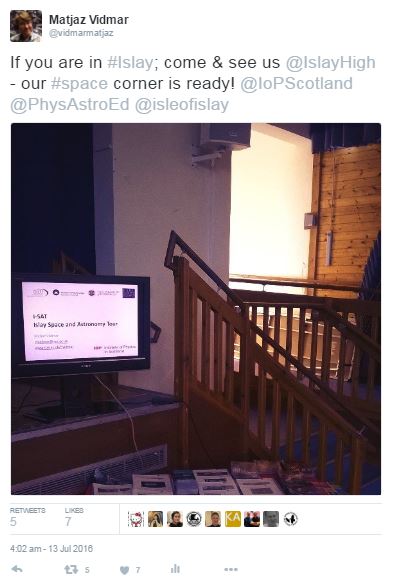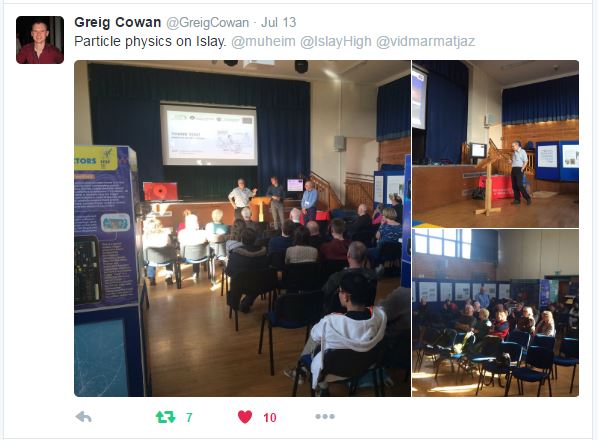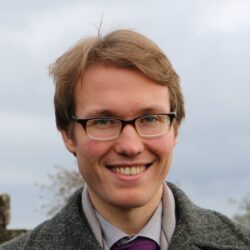This is a slightly late update on another outreach project I was involved with this Summer. Between 10th-14th July 2016, “Heavy Flavour – Quo Vadis?” workshop was organised by the Particle Physics Group, School of Physics and Astronomy, The University of Edinburgh, at the Ardbeg Distillery on Islay.
The aim of the workshop was to the future direction of research for heavy flavour physics, so-called as it involves the study of the heavy beauty and charm quarks that are produced in large numbers at the CERN Large Hadron Collider.
In parallel with the workshop, a series of public outreach events were held at Bowmore High School between 12th-14th July 2016, organised on behalf of the Particle Physics Group by Alan Walker, Director of Particle Physics for Scottish Schools (PP4SS), and the local Science teacher, Russell Pollock. This comprised of three joint exhibitions: Particle Physics for Scottish Schools Exhibition, From Maxwell to Higgs Exhibition (Royal Society Edinburgh) and I-SAT: Islay Space and Astronomy Tour.

The latter, Islay Space and Astronomy Tour (I-SAT), was a new invited project I designed specifically for this event on the basis of an IoP in Scotland Public Engagement Grant. In particular, I was asked to develop an interactive display related to my research, which concerns the applications of basic research and innovation partnerships between scientists and local entrepreneurs in the Space Industry in Scotland and to give a talk about science, technology and innovation in Astronomy and Space Science at the evening public session.
Interactive Display and Exhibition Talks
The display included a rolling loop explaining key features and current finding of my research and a selection of relevant info-sheets produced by Science and Technology facilities Council (STFC) and Institute of Physics (IoP).

I was near the display for most of the time exhibition was open and have regularly given short (15min) informal talks small groups of people to explain my work further.
It IS Rocket Science! – Building Scotland’s Space Sector
Building on detailed micro-level studies of innovation process my research suggests that the further development of Scottish Space Sector rests on matching the right people and institutions, who can then trade resources, knowledge and skills
Hence, I am using Social Network Analysis to map out the knowledge network(s) of the Space Industry in Scotland in order to identify its key systemic characteristics and outline the contours of the interactions (knowledge flows) between new product development (NPD) processes and its environment are the key for understanding which external factors most significantly influence the success of commercialisation of emerging Space technologies.
However, illuminating this network and characterising its effects is not trivial – after all, who said it was not rocket science?
Evening Talk
The series of events also included a public session with two presentations, one by the organiser of the workshop, Prof Franz Muheim, on “Higgs Bosons, Antimatter and all that” and the other my own on “Astrotechnology – and how it changed the World”. The event was well attended and well received by the local community (see below).

Astrotechnology – and How it Changed the World?
Astronomy research is both driving the technological advances as well as being shaped by them. From ancient telescopes to modern infra-red detectors simulations, the practice of Astronomy is very much rooted in physical objects – most of them located down here on Earth!
Using an example of such an object, an ordinary DSLR camera, this talk will afford a fly-by tour of the key astronomical technologies, how did they come about and what did they do for the science as well as for the society. We will examine the way Space innovation is allowing us to see the past and the future, the distant and the invisible, to experience reality well beyond our imagination and then emerge in the world to change it for the better.
What have the Space ever done for us, again?
So, how did it go?
Though our initial estimate was to attract about 300 visitors to the exhibition and the evening event combined, this turned out to be relatively ambitious, in particular as the events happen to coincide with unusually good weather for Islay, which led to many (in particular younger) audiences to try and spend more time outdoors. In the end, we have had approximately 100 unique visitors to the events in total, the evening talk being attended by around 30 people. Given the small population on Islay (around 3000 total), this is still a significant turnout.
More importantly, the visitors were very interested in the events and thought them to be of high quality. Some commented:
“Great interactive exhibition.”
“Great initiative – never had anything like that on islands when I grew up.”
“When are you coming back?”
Importantly, we engaged with several groups of high school children, who are thinking about studying science, and have said that this positive experience motivated them even more. Furthermore, noticing the event activities on Twitter (announcements alone reached over 6,700 impressions and 115 engagements), some were already advocating future locations to visit, which we would be more than happy to follow up!
More information (including more photos) about the activities on Islay can be found
- on Twitter: @GreigCowan; @muheim; @vidmarmatjaz
- on the web: http://www.ph.ed.ac.uk/news/2016/science-outreach-16-07-19
- in local news: http://www.islayblog.com/2016entries/20160708-particle-physics-islay.shtml
Finally, none of this would be possible without financial support from the IoP in Scotland Public Engagement Grant and the Particle Physics Group at the School of Physics and Astronomy, and the generous hospitality of the Islay High School, Bowmore.

